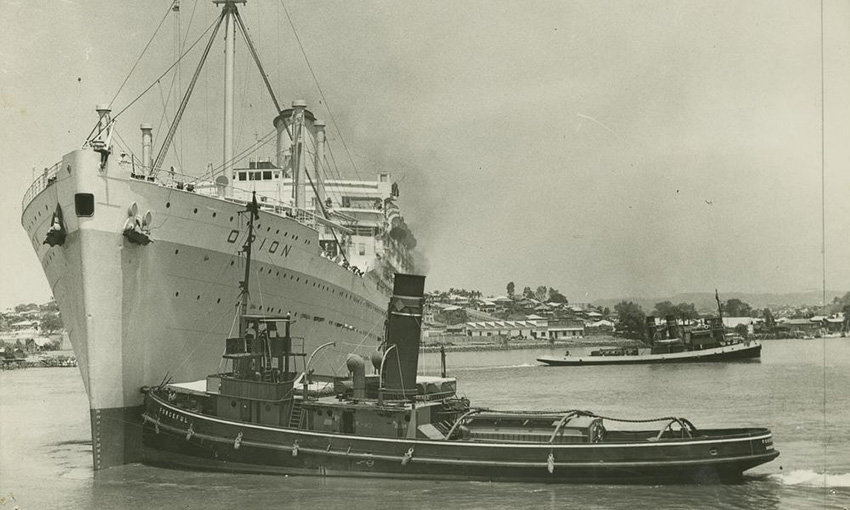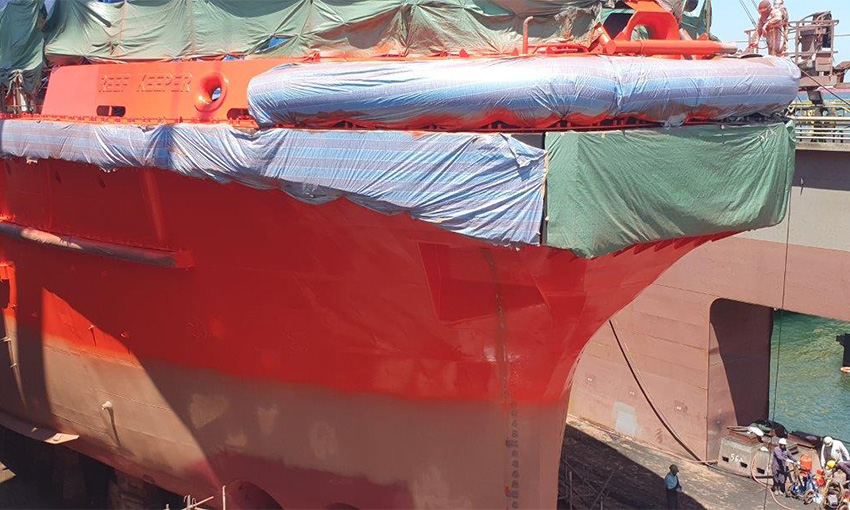By Mark Walker
IMAGINE, if you will, a furious ocean, cyclonic winds, mountainous seas, and a propellor missing one or more of its blades, unable to push your ship clear of a rocky lee shore. Out of the pitiless darkness comes a glimmer of hope. A small, furiously smoke-belching, bouncing, rolling, cork-screwing, searchlit, bobbing toy of a vessel, the insect like deckhands aboard her frantically attempting to throw a tow line to your stricken, labouring vessel.
This was the very scene that greeted the more than 100 passengers and crew aboard the E & A liner, S.S. Arafura, at 0200 on 1 March 1929, when the ocean-going steam tug Forceful appeared out of the murk, to replace the S/T Coringa, whose steering gear had failed and, swamped by huge waves, was forced to retire after the tow line parted.
It took the hard-working crew on Forceful another 11 hours to secure their tow, made even more difficult because Arafura’s engines had now stopped. The violence of the sea state again caused the tow line to part at 0600 the following day. Soon resecured, for the next two days, S/T Forceful faithfully towed the stricken and now engine-less liner all the way from off Gladstone down to Brisbane, preventing the loss of the vessel and saving all those aboard from near-certain death.
War years and beyond
Later in her much-storied life, commissioned as HMAS Forceful, she was requisitioned during WWII by the Navy for use as a tug in Fremantle, before sailing north to Darwin where she rescued the aircrew of a downed bomber, and later still, rescued several more aircrew while stationed in the Torres Strait, assisting with the logistics of the Allied pushback of the Imperial Japanese forces in Papua New Guinea.
Postwar, S/T Forceful returned to her former life as a commercial deep sea tug in the Port of Brisbane, assisting the berthing of warships, cargo vessels and ocean liners, in and out of the Brisbane River. She retired, a gallant old lady of the Brisbane waterfront, in 1970, and the following year, became the founding exhibit of the newly formed Queensland Maritime Museum (QMM).
She then commenced a new life, exciting and intriguing tourists, both local and international, on day trips on the river and out to the Bay Islands for the next 35 years until, at the grand old age of 80, she was unable to pass the modern, more stringent safety regulations (required if she was to keep plying her wares and taking tourists afloat), and was retired from active steaming to her berth at QMM on Southbank.
And there she sat for a further 15 years until Queensland’s Maritime Safety officials became concerned at her advancing age, and the condition of her hull plating, and requested an up-to-date survey to confirm she was still safe to be afloat on the river.
They also expressed concerns about her sheer bulk, and inability to power herself, in the event of another flood like the 2011 Brisbane flood that did so much damage to vessels and riverside infrastructure.
Issues arise
At 295 tonnes and 38 metres in length, S/T Forceful is a big lump of steel to be floating loose on the river and could have become a serious risk had she broken away from her moorings. Government agencies were especially concerned about her height, and the reduction in clearance under several low Brisbane bridges, especially during flood events, which might make an unpowered Forceful something of a loose cannon, inflicting serious damage to critical infrastructure.
Once hauled from the river for her survey inspection she was found to be in far worse condition than some had thought, with serious corrosion in her sheer strake, and some pre-existing patches in her rounded nether regions requiring re-welding or replating.
While initially committed to returning Forceful to her berth at Southbank, the MSQ directive that she no longer berth there due to safety concerns, led QMM on a long and fruitless search for an alternate mooring or berth, elsewhere on the river.
It was even contemplated that she should come permanently ashore and end her life as a static display somewhere, but again, her huge bulk told against her as, at 10 metres tall out of the water, it was difficult to find a home for her where none of her new neighbours objected.
A difficult decision
Finally, and tragically, after 30 months on the hardstand, bleeding money at the rate of up to $700 per day, her custodians at the QMM had no choice but to accept there was no solution other than to order her immediate demolition.
Faced with saving Forceful or saving the museum, they made the obvious and sensible choice, and so Forceful’s fate was decided.
Perhaps even more sadly, even after repeated efforts by first QMM, and latterly by other groups of concerned citizens who did not wish to see her demolished, no government agency was willing to take her on, or provide her with a new home.
Sadder still is the fact that a workable solution was found – one that not only would have saved Forceful from the scrapheap, but would have lead to her eventually being restored, and returned once more to the river that was her home for most of her life.
The genius solution, proposed by maritime workers who understood the realities, modelled on successful heritage restoration yards around the world, was to place her on a barge where she could not sink, nor pollute the waterways, nor become a missile floating free on the river, and where she could have been gradually restored by entirely volunteer labour, over several years, at a much reduced cost compared to a commercial restoration.
Had the various stakeholders been more keen to save her, or had they seriously contemplated this alternate methodology sooner, perhaps Brisbane’s iconic steam tug could have been saved for posterity. Perhaps, if the people of Queensland had cared more, they might have made more of a fuss and forced government and its agencies to take a more respectful approach to such an iconic symbol of our maritime heritage.
Unfortunately, this is not generally the way of governments, anywhere, and especially in this country, where heritage is almost a dirty word. Had S/T Forceful a more storied war record – or had she been present at the signing of a treaty or some other historic event – perhaps more energy would have been directed towards saving her from the wrecker’s gas axe.
Vale
But in the end, she was just a humble tugboat. Her epitaph, if ever a gravestone were possible, should read: The Last Ocean Going Steam Tug Boat in the Southern Hemisphere: 1925 – 2023.
Alas, such is not to be. By the time you read this, she will be gone, forever. Disembowelled, her expensive copper pipes removed from her capacious boiler rooms. The harmful asbestos lagging around her boilers carefully removed. Her pumps, whistles, lifeboats and other bric-a-brac removed to provide static exhibits at the museum.
But her cheerful chuffing and her deep-throated steam hooter will be heard no more along the Brisbane River. She is gone. Like so much of our history deemed irrelevant to the bright, shiny future of tomorrow. She is gone. Her tall smokestack puffing steadily, the grey wisps of smoke dissipating in the onshore breeze, gone from the river forever.
Vale, Steam Tug Forceful. Thank you for your service.





